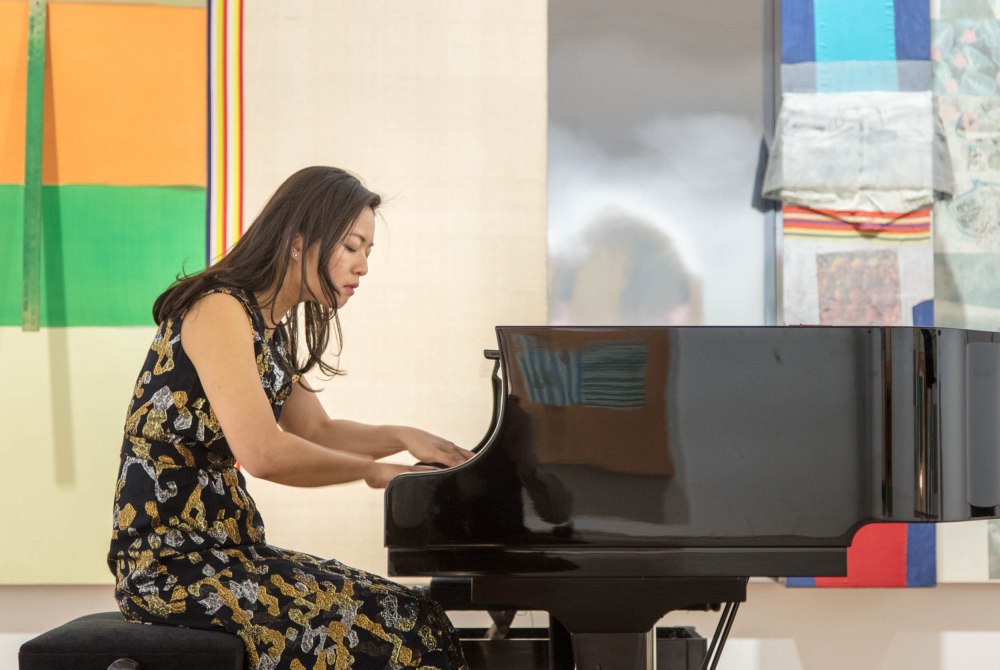During the summer of 1952, composer John Cage staged a happening that was going to change the world of music and art forever. At Black Mountain College in North Carolina, in the college dining hall, the audience listened to Cage read from an essay he had written on the relationship between music and Zen Buddhism. He punctuated his talk with long silences. It must have read like an extended poem.
Cage’s preoccupation with silence as musical form lead to his publishing of 4’33’’, his silent work, that same year.

At that same college event, four white paintings had been suspended in the air above the audience. Robert Rauschenberg’s pristine White Paintings incarnated what Cage had expressed in words and in silence, namely painted space onto which the outside world could be projected. These paintings could change according to where they were hung; daylight, nature, harsh light spots could cast various shadows across the work. The canvas was a receptacle. A living tableau even, which changed from minute to minute – if only we were attentive enough. And that was the point – conceptual art as it came to be known, required us to think and to fine-tune our senses. And senses are at their most acute in stillness and space.
Knowing this, Cage in his 4’33” silent composition, drew our attention to ambient sound. For him there was no difference between sounds and music.
To this day, these ideas seem radical!

Inspired by Cage’s and Rauschenberg’s works and ideas, pianist Annie Yim invited an audience to attend the premier of ‘Conceptual Concert in Three Acts’, at the Thaddaeus Ropac Gallery, London the other evening.
The concert room could barely accommodate the fashionable crowd that gathered for the event. Many had to make do with standing at the back, for along the walls, either side of them, precious Rauschenberg paintings had been hung. They formed part of a wonderful exhibition entitled Spreads 1975-83, the Thaddaeus-Ropac Gallery is putting on at the moment.That there wasn’t a white painting in sight was no bad thing and was consistent with the artistic layering that was about to take place in an evening of music, art and poetry.
At the front, a shiny black piano waited to be played. It was positioned between what seemed to be two huge canvases covered in sheets.
A tape recorder was switched on. ‘Nature is better than Art,’ said a gentle voice from the past belonging to the inimitable John Cage.
Annie Yim, founder of MusicArt which brings different art forms together, walked on stage to perform The Seasons composed by Cage in 1947. Sitting down at the piano she launched into winter: stark chords; spring: frolicking and skittering notes across the keyboard and summer: lyrical melodies, interspersed with mischievous interludes. Nuanced, precise playing of what is still considered to be experimental material is often hard to pull off and Annie Yim did so with gusto! The composition ended abruptly.
Act 11 was given over to new music by distinguished composer, Raymond Yiu which contained jazz elements and a beautiful duet played by Yim and the composer himself.
Meanwhile, Kayo Chingonyi, award-winning poet, read his own compositions. His poem entitled Matrix – Who’s to say, a tribute to Cage’s reverence for everyday (musical) sounds was particularly memorable and pertinent.
The latter part of the Act was devoted to Cage’s wonderful musings on the creative process: ‘I am trying to change my habits of seeing. I am trying to be unfamiliar with what I’m doing’ (what dedication to permanent invention!) and poem To Whom which he read out at opening show of Rauschenberg’s White Paintings at the Stable Gallery in 1953. For me, one of the highlights of the evening was to listen to him speak.
And finally Act 111 unfolded. The sheets were removed to reveal two large mirrors. Pianist Yim sat down at the piano and as instructed by Cage in the 4’33” score, didn’t play a note.
Silence prevailed for 4’33’’. It was an entrancing experience. At first, time really did seem to stand still. As the performers froze, so did the audience. Very soon bemused expressions started to reflect in the mirror, bobbing heads looked this way and that. Others, worn out by the lead up towards Christmas no doubt, simply closed their eyes and napped. Tiny sounds started to emerge from the stillness: nails clinking a wine glass, creaking chairs, stifled coughs. As if on cue, a rasping motorbike broke into the space. A tiny part of me felt it had been orchestrated but it didn’t matter for the mirrors revealed a room of smiling faces.
Cage had woven his magic as had MusicArt. It had been a bold enterprise by Yim and her team. She risked putting too many eggs into one basket. But overall, the project was cohesive, expertly performed by all and thought provoking, shedding further light on two iconic figures.
KH
Catch Rauschenberg Spreads and John Cage Ryoanji exhibitions at the Thaddaeus Ropac Gallery, 37 Dover Street, London. On until 26 January 2019.
How To Get Out of the Cage. Engaging documentary featuring John Cage by award-winning film-maker Frank Scheffer on Youtube.
One Comment Add yours